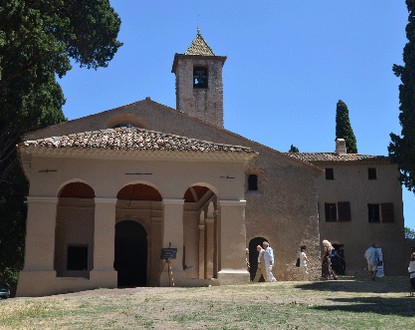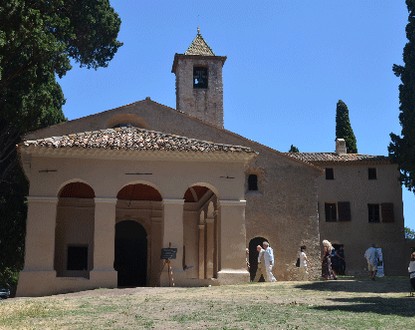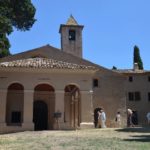
The prize* is awarded for the rehabilitation of the Sanctuary of Notre-Dame de Vie. It is the campaign that has gathered the most donations in the A-M since the establishment of the Alpes-Maritimes Heritage Foundation delegation in 2007. 15% of the patrons from Alpes Maritimes supported this project.

THE CHAPEL
The Notre Dame de Vie chapel was listed in the Supplementary Inventory of Historical Monuments in 1927; the priory and its surroundings have been classified as historical monuments since 1938. It showcases all the aesthetic characteristics of the religious monuments of the 17th century and evokes, through its exterior layout framed by cypress trees, the Tuscan landscapes.
The Notre-Dame-de-Vie chapel was built in the style of rural chapels of the Alpes-Maritimes, with a rectangular plan, a single nave, a double-pitched roof, and a flat apse.
The bell tower, covered with typical Lombard bands of the second Romanesque art, is the oldest part, built in the 13th century.
The priory or hermitage is believed to have been built in 1613 to house a chaplain or pilgrims. As for the chapel, it was rebuilt from 1655 to 1656, as the old one was falling into disrepair.
Since then, it has maintained its original structure, though it has undergone some restoration work (bell tower, roof, parts of the facade).
A MAJOR PLACE OF WORSHIP
This site, dedicated to worship, gathered numerous faithful, particularly during long nocturnal processions organized by the White Penitents, a rich and powerful confraternity from Mougins. For ten centuries, many who came to Notre-Dame-de-Vie implored the Holy Virgin to ensure them good harvests. The walls covered with ex-votos testify to this devotion.
Until 1930, the Notre-Dame-de-Vie chapel was a “sanctuary of respite.” Families came from all over the region to baptize their stillborn children. It is said that they resurrected long enough to receive the sacraments. They were then buried in the garden adjacent to the priory. Until the 1970s, the Chapel’s garden was the scene of grand celebrations and processions honoring Saint Innocence, the village’s patroness. Even today, masses gather with great fervor, people from Mougins, Cannet, and Grasse.
IDENTICAL RESTORATION
Interior and exterior rehabilitation of the buildings
• Restoration of facade plasters and limewashes respecting the original colors and textures;
• Roof restoration;
• Reopening of blocked openings;
• Renovation of electrical networks to allow lighting and heating of the site;
• Restoration of the terracotta floor tiles, woodwork, and refreshing of the paintings.
• The priory was refurbished to be converted into a small museum where the chapel’s treasure is now displayed.
Rehabilitation of the green spaces and surroundings
• Restoration of retaining walls, cobbled paths, and walkways;
• Facade cleaning of ancient stones.
• The surroundings of the chapel were also arranged to accommodate dismantlable structures for organizing festive and cultural events.
• The objective is to restore the site to its full splendor and to allow it to regain its worship destination while transforming the priory into a small cultural center.
• Replacement of dangerous cypress trees
• Accessibility improvements for persons with reduced mobility (toilets, ramps, etc.).
• Enhancement of the site with LED lighting and special lighting for events
• The colors and textures of the facades recall the original chapel.
THE TREASURE OF NOTRE DAME DE VIE
The museum space housing the Treasure of the chapel is divided into different parts: Gallo-Roman remains, the history of the chapel with its numerous ex-votos. It also has a section dedicated to processions and Penitents’ confraternities. Visitors can now discover valuable items such as funerary steles, the reliquary arm of St. Honoratus, founding Abbot of Lérins, or various sculptures of the Virgin Mary. On the first floor, a documentation room provides visitors with more information. Everything has been renovated from the floors to the ceilings.
FUNDING
Cost of the work: €1,076,688
Donations: €197,638
Subsidies:
• €300,000 from the General Council
• €87,167 from the DRAC
• €60,000 from the Regional Council
• €30,000 from the parliamentary reserve of the Deputy and Mayor of Cannet, Michèle Tabarot
Donations and contributions from the Heritage Foundation: €247,462, which is 23% of the project.
